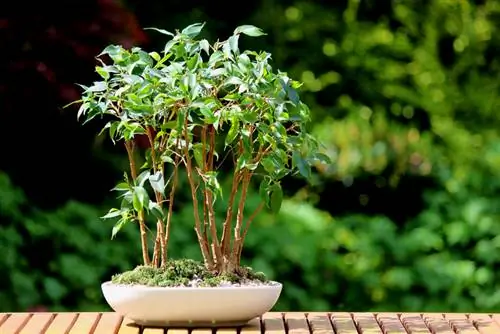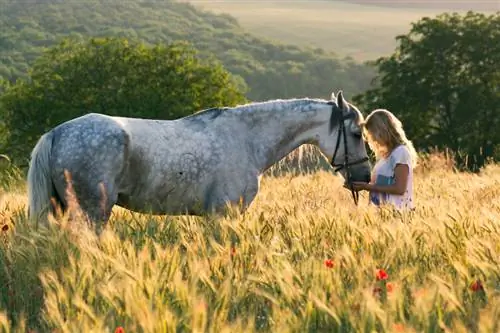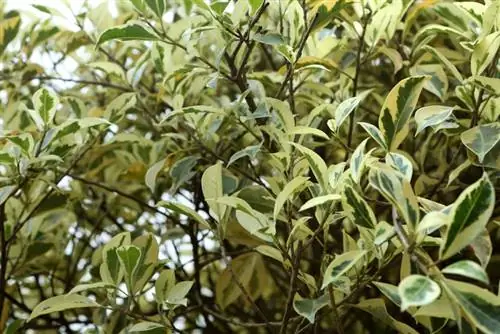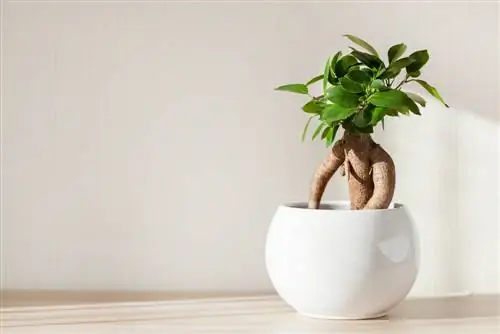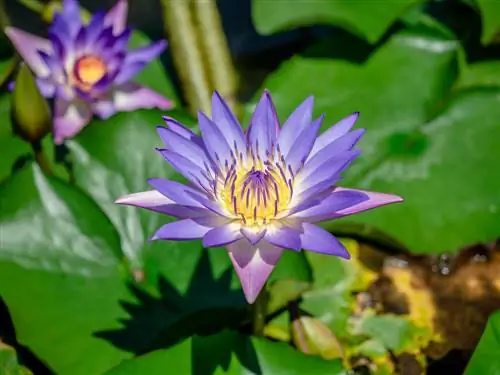- Author admin [email protected].
- Public 2023-12-16 16:46.
- Last modified 2025-06-01 06:02.
With its good-natured pruning tolerance and modest requirements, the birch fig advertises itself as the ideal bonsai for beginners. Have you been captivated by the fascinating Asian garden art of mini trees? Then familiarize yourself with all the relevant measures for the best care of a Benjamini as a bonsai.
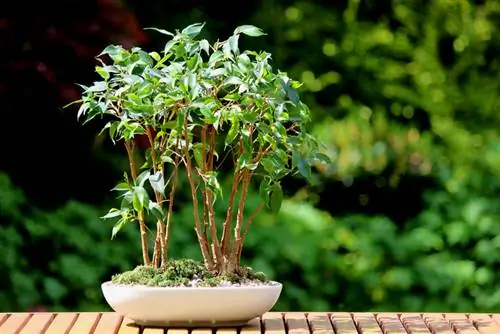
How do I properly care for a Ficus Benjamina Bonsai?
In order to ideally care for a Ficus Benjamina Bonsai, it needs a bright location, alternately moist substrate, regular fertilizing, careful pruning, artificial autumn, plucking and possibly wiring the shoots to achieve the desired shape.
The ideal location for a ficus bonsai
For harmonious growth, a place on the balcony is desirable from May to September. The location should be bright and warm, with protection from the blazing midday sun. When temperatures approach the critical 15 degrees mark in autumn, put the birch fig away. In the light-flooded window seat at temperatures of around 18 degrees Celsius, your mini Benjamin will survive the cold season.
Watering a birch fig as a bonsai - how do I do it correctly?
Whether in a large format or as a bonsai, the birch fig values a substrate that is alternately moist. If the surface of the soil is noticeably dry, water thoroughly. Spray the root disc with soft water until it drips out of the bottom opening. The substrate should dry out again until the next watering, but never dry out. Please note that your Benjamini reacts to waterlogging and dryness by dropping its leaves.
Fertilize Ficus benjamina as a bonsai - when and how often?
In view of the small substrate volume, the nutrient requirements of a birch fig as a bonsai are higher than you are used to with a normal-sized houseplant. From March to September, please administer a liquid bonsai fertilizer (€4.00 on Amazon) every week. From October to February, the fertilization intervals increase significantly to 4 to 6 weeks. Spray the substrate with soft water before and after to effectively prevent root damage caused by the fertilizer s alts.
Tips for pruning - How to keep Benjamini in bonsai format
It is primarily the skillful pruning that will help you wrest the delicate shape of a bonsai from your birch fig. The exemplary cut follows the motto of deliberately alternating between cutting and letting it grow. The more continuously you cut, the more delicate the growth. How to do it right:
- Cut every 6 weeks from spring to autumn
- Best time is between March and July
- Short new shoots with 5 to 7 leaves down to 2 or 3 leaves
- Place the bonsai scissors 2 to 3 mm above a sleeping eye
- Short shoots protruding from the crown shape
- Ideally thin out dead branches in early spring
When making cuts on your birch fig, make sure that you don't end up with a thick branch over a thinner branch. Please wear gloves to protect yourself from the poisonous plant sap. By placing a small piece of kitchen fleece on each fresh cut, the sticky latex cannot drip onto the leaves.
Under no circumstances should pruning a birch fig as a bonsai follow a firmly cemented schedule. The old masters of Asian garden art don't constantly abuse a Benjamini with scissors and pliers. Instead, leave the bonsai undisturbed for a longer period of time so that you can enjoy its unique appearance every day.
Artificial autumn creates delicate leaves
The secret of small leaves on a bonsai is based on simulating autumn conditions. To do this, cut off the leaves during the growing season and leave the petiole on the shoot. After a while the stems dry up and fall off. Smaller leaves than before emerge from the buds underneath. The more often you repeat the artificial autumn, the more graceful the foliage becomes. The prerequisite is a bright to sunny location and regeneration phases of 6 to 12 months.
Repot professionally - This is what you need to pay attention to when doing a bonsai
Once a bonsai has completely rooted through its pot, it is high time to repot it. At Benjamini this is usually required every 2 to 4 years. The length of the new bonsai pot should be at least three quarters of the plant height. Loosen the root ball from the edge of the bowl with a sickle knife and lift out the bonsai. Use a root hook to loosen the ball of soil to shake off the substrate. Proceed as follows:
- Lay out a plastic grid in the new bonsai pot as drainage
- Pour a thin layer of 2 parts pricking soil and 1 part each of akadama and expanded clay on top
- Spread the root system of the Benjamini bonsai in a star shape on the substrate
- Fill with soil all around so that the previous planting depth is maintained
Use a wooden stick to press the substrate firmly and water with soft water. In the following 4 to 6 weeks, the stressed bonsai is not fertilized, cut or wired.
Tip
So that the birch fig turns into a three-dimensional bonsai sculpture, selected branches are wired in early spring. Special bonsai wire is wrapped around the flexible shoots at a 45 degree angle. Buds and leaves must not get under the wire. Within 4 to 6 weeks, direct a branch in the desired direction and then remove the wire again.

